

Dixie. Nickname for the Southern United States Dark red indicates the states almost always included in modern-day definitions of Dixie, red – sometimes included (see Southern United States for the U.S.
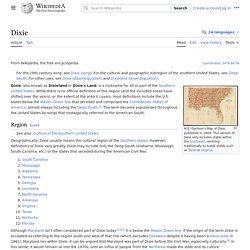
Census definition), while pale red – occasionally included due to their historic connections to the South.[1][2][3][4] Dixie. Old South. American South that was part of the British colonies Regional definitions vary from source to source.

List of colonial governors of Louisiana. Natchez people. Sendero de lágrimas. Mapa y ruta de traslados.
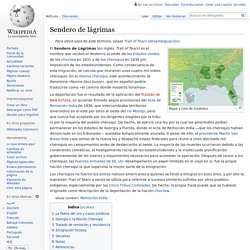
El Sendero de Lágrimas (en inglés, Trail of Tears) es el nombre que recibió el destierro al oeste de los Estados Unidos de los choctaw en 1831 y de los cheroquis en 1838 por imposición de los estadounidenses. Como consecuencia de esta migración, se calcula que murieron unos cuatro mil indios cheroquis. En el idioma cheroqui, este acontecimiento se denomina «Nunna daul Isunyi», que en español podría traducirse como «el camino donde nosotros lloramos».
La deportación fue el resultado de la aplicación del Tratado de New Echota, un acuerdo firmado según provisiones del Acta de Remoción India de 1830, que intercambiaba territorios amerindios en el este por otros al oeste del río Misisipi, pero que nunca fue aceptado por los dirigentes elegidos por la tribu ni por la mayoría del pueblo cheroqui. La fiebre del oro y casos jurídicos[editar] Georgia y la Nación Cheroqui[editar] Tratado de remoción y resistencia[editar] En 1835, Jackson nombró al reverendo John F. Dust Bowl. Granjero y sus dos hijos durante una tormenta de polvo, en el condado de Cimarron, Oklahoma, en 1936.
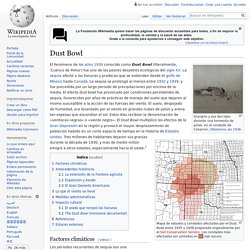
Mapa de estados y condados afectados por el Dust Bowl entre 1935 y 1938 preparado originalmente por el Soil Conservation Service. Los condados más afectados son pintados en rojo oscuro. El fenómeno de los años 1930 conocido como Dust Bowl (literalmente, 'Cuenco de Polvo') fue uno de los peores desastres ecológicos del siglo XX. La sequía afectó a las llanuras y praderas que se extienden desde el golfo de México hasta Canadá. La sequía se prolongó al menos entre 1932 y 1939, y fue precedida por un largo periodo de precipitaciones por encima de la media. Factores climáticos[editar] Los periodos recurrentes de sequía son una característica común a las latitudes medias, y son modulados por el fenómeno ENSO (El Niño–Southern Oscillation). Antecedentes históricos[editar] Adams–Onís Treaty. History[edit] The Treaty was negotiated by John Quincy Adams, the Secretary of State under U.S.

President James Monroe, and the Spanish "minister plenipotentiary" (diplomatic envoy) Luis de Onís y González-Vara, during the reign of King Ferdinand VII.[6] Florida[edit] Spain had long rejected repeated American efforts to purchase Florida. But by 1818, Spain was facing a troubling colonial situation in which the cession of Florida made sense.
To stop the Seminole based in East Florida from raiding Georgia settlements and offering havens for runaway slaves, the U.S. Adams said the U.S. had to take control because Florida (along the border of Georgia & Alabama Territory) had become "a derelict open to the occupancy of every enemy, civilized or savage, of the United States, and serving no other earthly purpose than as a post of annoyance to them Louisiana[edit] French and Indian Wars. The French and Indian Wars is a name used in the United States for a series of conflicts that occurred in North America between 1688 and 1763 and were related to the European dynastic wars.
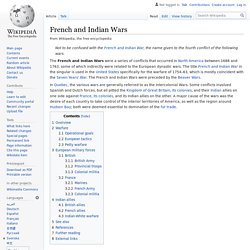
The title French and Indian War in the singular is used in the United States specifically for the warfare of 1754–63, the North American colonial counterpart to the Seven Years' War in Europe. The French and Indian Wars were preceded by the Beaver Wars. In Quebec, Canada, a former French colony, the wars are generally referred to as the War of the Conquest. Some conflicts involved Spanish and Dutch forces, but all pitted the Kingdom of Great Britain, its colonies, and their Indian allies on one side against France, its colonies, and its Indian allies on the other.
Military of New France. The Military of New France consisted of a mix of regular soldiers of the French Army, French Navy and Canadien volunteer military units, supported by independent American Indian Allies.[1] Prior to 1690 most French troops were sent from France, but challenges of logistics and localization meant that by 1690 (In 1669 Louis XIV ordered that all valid men of New France between the ages of 16 and 60 must do mandatory military service so every parish would have its own militia), the number of Canadian volunteers increased relative to the number of professional troops and by the 1720s Canadiens dominated military service.[2]
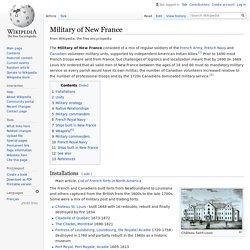
Colonial history of the United States. Aspect of history The colonial history of the United States covers the history of European colonization of America from the early 16th century until the incorporation of the colonies into the United States of America.

In the late 16th century, England, France, Castile, and the Dutch Republic launched major colonization programs in America.[1] The death rate was very high among those who arrived first, and some early attempts disappeared altogether, such as the English Lost Colony of Roanoke. Nevertheless, successful colonies were established within several decades. Confederate Monuments Are Coming Down Across the Country. Here’s a List. - The New York Times.